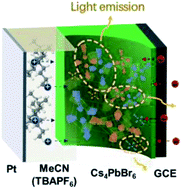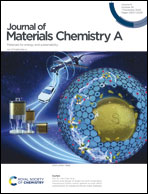Efficient electronic coupling and heterogeneous charge transport of zero-dimensional Cs4PbBr6 perovskite emitters†
Abstract
Organic and/or inorganic halide perovskites have become a new class of optoelectronic materials by virtue of excellent attractive physical and chemical characteristics. In this context, the zero-dimensional (0-D) cesium lead bromide (Cs4PbBr6) perovskite with outstanding photoluminescence (PL) properties has been recognized as the most promising candidate. However, the electron transfer dynamics and electrochemical behaviors of Cs4PbBr6 emitters still remain unclear. Herein, we prepared the 0-D Cs4PbBr6 perovskite emitters and investigated the exciton transport and electrochemical dynamics by utilizing temperature-dependent transient photoluminescence (TRPL) and electrogenerated chemiluminescence (ECL) techniques, respectively. Stronger electronic coupling of Cs4PbBr6 emitters arises from the overlap of electronic wavefunctions, indicating the increased possibility for the generation of electrochemiluminescence. Through the determination of the diffusion coefficient and electron-transfer rate by using an electrochemical method, we confirm that effective heterogeneous charge transfer at the interface of the electrode and electrolyte results in red-shifted ECL emission in the presence of benzoyl peroxide (BPO) as the co-reactant. The development of zero-dimensional perovskite emitters opens up a new avenue in the field of emerging optoelectronic and biosensing technologies, including but not limited to ECL devices, ECL immunoassays, organic light-emitting diodes, light-emitting electrochemical cells, and other bio-related detections.



 Please wait while we load your content...
Please wait while we load your content...